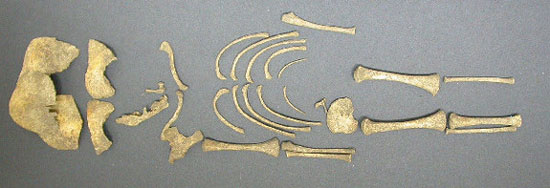The mystery is revealed from 35 infant skeletons
The skeletons were preserved for nearly a century in 35 small boxes, each containing enough of an infant's complete skeleton, estimated to be about 1,800 years old.
Dr. Jill Eyers, an archaeologist and director of Chiltern Archaeological Organization (UK) estimates that these skeletons are about 1,800 years old, having existed since Britain remained in the Roman Empire.
What remained until the time they were excavated in an English country in 1912 was put into the box. Jill Eyers later found them in a museum archive."We really feel heartbroken when opening all the boxes and looking for babies inside," Eyers said. "They have been very well preserved for about 100 years."

The skeleton of one of the 35 babies is found at
Roman villa in Hambleden village. (Source: English Heritage)
There are 35 babies who die immediately after being born. But these deaths are clearly not natural deaths. Eyers suspect the cause of this scene originates from a brothel.
Almost a century ago, in 1912, Alfred Cocks Heneage, who was in charge of the Buckinghamshire Museum, excavated at a Roman mansion in Hambleden village. Later, he was also responsible for bringing the babies into the box
The excavation team discovered 103 bodies including 97 newborns, three older children and three adults, mostly in the northern area of the villa.
In a report published nine years later, Cocks came up with research conclusions around adult skulls, along with plans to build villas, and about pottery and other items found in there. What happened to those babies was not mentioned.
Now, Eyers and his colleague Simon Mays conduct research on the 35 most complete and intact skeletons.
On the reason why Cocks did not examine the infant skull, Mays said: 'It is possible that at that time, people were not interested in studying babies'. Instead, in the early 20th century in England, archaeologists focused on trying to reconstruct the history of the British. Also, 'I think Cocks can't imagine that kids were killed', Eyers explained.
Before and during birth, the bones of a child develop rapidly, so by checking the length of the bones, including the bones of the arms and the femur, it can be seen that death occurred within two weeks after birth.
When Mays examined the rest of 35 babies, he found that most of them reached about 38 to 40 weeks of age, the time that most babies were born.'The reason we think these deaths are unusual is that if they die naturally, there must be an earlier case of death, there is a case of death during the birth, some die after a few days or weeks. birth , "he said.
In fact, the sudden increase in the number of deaths within the delivery period is consistent with the profile of newborns found in a drainage system in Ashkelon - the Israeli area that has suffered from La Code occupied. Accordingly, scientists believe that this place used to be a brothel. Unwanted babies are born because prostitutes do not have appropriate contraception.

Today's Hambleden Valley, where excavations took place almost a century ago.
'This area is very rich so poverty and disease cannot be the leading cause, except for the reason that this is a brothel' , Eyers said.
Evidence of traffic conditions or objects with pornographic design are found to increase that suspicion. However, Mays disagrees with this argument.
"I think that is a way that parents do to be able to choose their family size," he explained. The children may be the children of the workers in the mansion and at the time, this was considered normal. He found much evidence to prove it in many areas in northwestern Europe in Roman times.
Until modern contraceptive methods are available, it is one of the ways to limit family size effectively and bring safety to the mother, he and Eyers previously wrote in an article published in the magazine. Archaeological science.
In Roman times, 'we know babies are not as valued as older children , ' Mays said. To be considered a real person, the child must reach a minimum of 6 months of age.
- Excavating 92 medieval skeletons in the English church
- Close up of weird red skeletons in the Milky Way galaxy
- When we were born, what could we see?
- Two 8,000-year-old 'Romeo and Juliet' skeletons
- Detecting an abnormal monster skeleton
- The famous mystery in history has been solved
- Mysterious skeleton of the alien planet washed up on the English coast
- The vampire bones discovered in Bulgaria
- Unearth 350 skeletons of Napoleon soldiers
- Why do babies not have tears or sweat?
- Two skeletons embracing each other in the ancient tomb
- Russia unearthed two intact dinosaur skeletons
 The truth about the mysterious red-haired giant at Lovelock Cave
The truth about the mysterious red-haired giant at Lovelock Cave Inunaki Tunnel: The haunted road leading into Japan's 'village of death'
Inunaki Tunnel: The haunted road leading into Japan's 'village of death' The mystery of the phenomenon of human reflection before dying
The mystery of the phenomenon of human reflection before dying 6 mysterious phenomena, although science has been developed for a long time, still cannot be answered
6 mysterious phenomena, although science has been developed for a long time, still cannot be answered